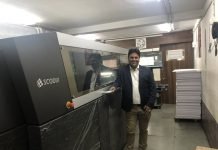Established in 1984, Aluva Kochi-based SN Press offers complete print solutions. Flourishes on a diet of book printing, brochures, magazines, tags and labels, SN Press started with a letterpress moving gradually to mini offset before investing in an HMT single-color machine. With growing print volumes, and feeling the need to add capacity, it added a second-hand 4-color Komori offset press in 1999. While the Komori served the purpose at the time, the company’s director, Sajeevan, wanted to add a new machine for producing exceptional quality print at a faster pace. Thus in 2013, he invested in a brand new Heidelberg Speedmaster SM 52 4-color press.
“With the addition of the Heidelberg, we became a one-stop print shop. Our investment was primarily aimed at delivering the numerous short-run print jobs that we get everyday, and the new Heidelberg press was and is best suited for such jobs. With this investment, we had everything in-house and the customer did not have to go anywhere for job work. Right from prepress, postpress, finishing, digital printing, wide format jumbo printing and binding – whatever was requested, we had the capacity to deliver,” shares Sajeevan. Almost 90% of Sajeevan’s commercial printing business comes from more than 100 small-scale printers from all over Kerala and around 80% of these orders are online.
The most recent investment for SN Press includes a brand new Komori Enthrone 429 sheetfed offset press, which Sajeevan added in 2018. However, soon after installation of the machine, floods hit Kerala, causing severe destruction of lives and infrastructure in the state. Sajeevan recalls, “We had just installed the machine when the floods hit us. The press was half submerged in water and we had to shut it down for months. However, we received very good support from Komori.”
Amitabh Jha, national service head for Komori adds, “In this special case, we assured SN Press of our full support. We gave very reasonable and low priced support for spare parts to the extent that the service given more than met the expectations of the customer, which is our goal – Kando, Beyond Expectation. Now the press is up and running. We ensured that whatever support we offered, the customer had to bear the minimum possible expenditure for it.”
The Enthrone 429 has a top speed of 13,000 sheets per hour with reduced change-over time. The machine can print on sheets ranging in thickness from 0.04 mm to .6 mm. According to Sajeevan, Komori machines are easy to run and manage. “The machine is completely trouble-free. Parts are also easily available. But mostly, it was our long association with Komori that made us choose them over any other brand,” he shares.
Talking about future plans, Sajeevan says, “Packaging is a good vertical now and some of the packaging companies are doing profitable business in Kochi. However, packaging requires investment in a lot of infrastructure and also demands a spacious unit. So, for now we are not thinking of venturing into that segment. Maybe in the next 2-3 years, we might consider it. Before anything else, we need to invest in land big enough for a packaging unit.”
















